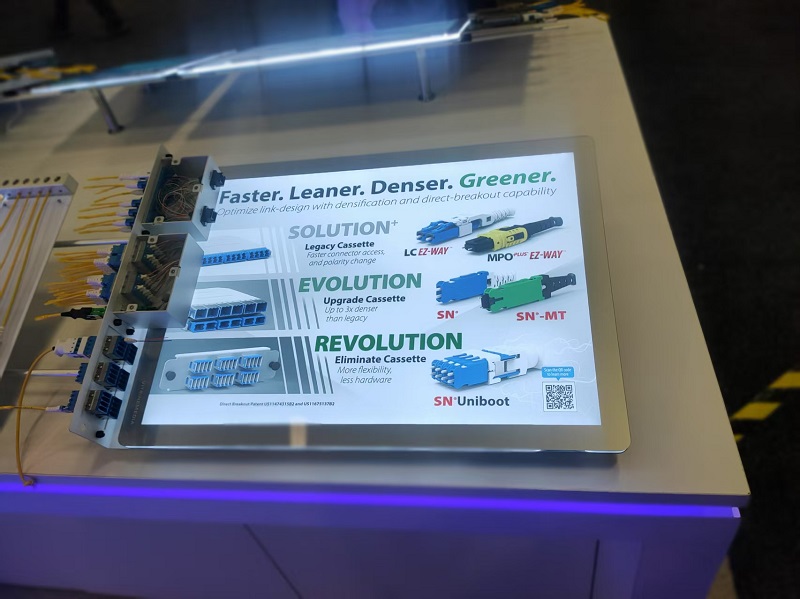From GTC to OFC(10): Connector for CPO 2025-04-20 Cfol
April,21, 2025, If NVIDIA's CPO demonstration at GTC brings new development impetus to the CPO industry chain, then the field of new optical connectors that realize the connection between CPO chips and optical fibers may be the most benefited. Traditional connector giants such as US Conec, Senko, Molex, and even Corning have all released their own CPO connector solutions, and there are also solutions from some start-up companies in this field.
US Conec's CPO solution is the Expanded Beam Optic Interconnect (EBO) solution developed in cooperation with 3M at the end of last year. This is a non-contact optical connection technology with lenses, similar to the solution proposed by Dr. Jian Bin of Litas. The non-contact optical connector technology has become increasingly mature. Friends from US Conec said that their CPO connectors can already achieve low insertion loss.
During this OFC, US Conec also announced the authorization of its MDC and MMC VSFF connectors to Sanwa in Japan and the authorization of MDC technology to T&S in China. This is also a new development after they reached a settlement in the patent lawsuit with Senko regarding the VSFF connector. Previously, Sumitomo had also obtained the authorization for the MMC connector. The feature of US Conec's products also lies in the general support for their DirectConec plug-and-play technology, a convenient plug-and-play technology, thus claiming to support higher density. Their previously introduced detachable FAU technology can also support reflow soldering applications.
Senko is a big winner in NVIDIA's CPO connection solution this time. The CudoForm company they acquired in 2022 manufactures integrated optical fiber connectors MPC based on metal precision stamping technology. These connectors come with aspherical lenses and V-grooves, featuring nanoscale precision, which helps with high-precision alignment of optical fibers and waveguides and can support a pitch of 250 micrometers or 127 micrometers. After resolving the patent dispute over the VSFF ultra-small connector with US Conec, Senko has an unprecedented lineup at this OFC. Not only NVIDIA, but Marvell also used Senko's 36Ch detachable metallized PIC connector MPC in their CPO demonstration this time.
In terms of CPO, Senko also showcased connectors for ELSFP external lasers, which support automatic alignment functions and can accurately blind-mate two low-loss MT connectors at once.

Another current hot spot in the competition within the connector field is the support for reflow soldering processes, and Senko also performs outstandingly in this regard.
Tom Marrapode, Director of Advanced Technology Development for Optical Connectors at Molex, told the editor before the exhibition that they launched many new products at this OFC, including the External Laser Source Interconnect System (ELSIS) for CPO, an optical-electrical connector that supports blind mating. Compared with US Conec and Senko, their products have many novel features in terms of ease of use, miniaturization, and other details.
Molex also launched the VersaBeam EBO expanded beam solution at this OFC, and the key part of it also uses 3M's EBO ferrule.
Corning is also a company in NVIDIA's CPO industry chain. Their GlassWorks AI solution includes SMF-28 thin-diameter bend-insensitive optical fiber, Contour Flow high-density optical cable, MMC16 and MMC24 connectors. For CPO, they specifically launched the FlexConect bend-insensitive optical fiber for short-distance use, and two concepts of detachable glass-based optical fiber-to-chip connectors: one uses Ranovus's ODIN® product, and the other uses GlobalFoundries' GF Fotonix™ packaging test chip.
Among domestic companies, besides T&S mentioned earlier, the FAU products of TFC are also stars in NVIDIA's industry chain. In fact, in the field of optical connectors, it is difficult to see the technical details behind just from the surface, and these details are the real focus of competition among various companies. During the exhibition this year, when passing by the Litas booth, I saw Dr. Jian busy writing something as he was about to go out and communicate with customers. He should have come up with some new technological inventions again.